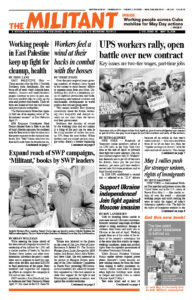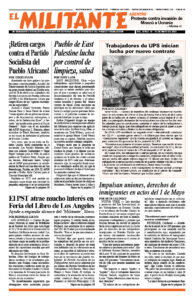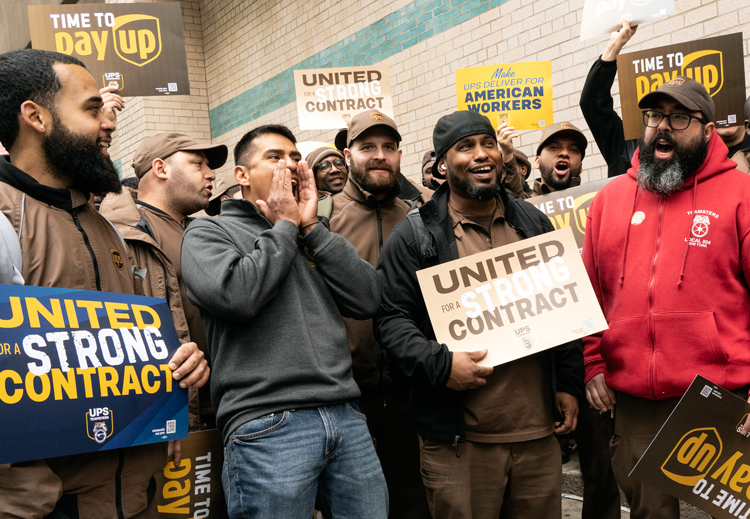NEW YORK — Hundreds of Teamsters union members rallied at six UPS hubs in the New York City area at the end of April to advance their fight for a new contract. The current contract expires July 31. Workers’ key demands are to get rid of two tiers for drivers, boost pay for part-time workers, get more part-time workers moved into full-time positions and to limit forced overtime.
In 2018 UPS established a second tier — referred to as “22.4” drivers because of an article in that year’s union contract — who earn anywhere from $3 to $6 an hour less than the “regular package car drivers” with the same amount of seniority. The change was imposed to boost the UPS bosses’ profits.
“We do the exact same work. We need to get the same rate of pay,” Jeffrey Johnson, a 22.4 driver, told the Militant during the rally at the Maspeth and Metro Queens hub April 27. “We can’t live on what they give us.”
Pay is also a big issue for part-time workers, largely those who sort packages or load the trucks. In New York they start out just a dollar or less above the $15-an-hour legal minimum wage.
“They need to make more of the part-timers full time,” Roland Linton, a driver at the Maspeth hub, said. “These are my brothers. We got to fight together.”
Depending on the time of year, many of the part-time workers only get 25 hours a week. Even if they have “progressed” to a higher pay bracket after four or five years, that’s not enough to raise a family, workers say.
“I began as an inside-outside guy,” Thomas Giammarino said. That means he loaded the trucks early in the morning and then went out with the driver to help make deliveries. From October to January he was promoted to being a 22.4 driver, but when business slowed he was sent back to loading and his hours were cut. “I had to get a second job at Home Depot,” he said.
Many workers noted the dangerous working conditions they face because UPS refuses to install air conditioning on the trucks. Drivers and helpers getting heat stroke is not unusual. “The truck can get to 120, even 130 degrees, on top of the dust,” said driver George Dyson. “We should get hazard pay.”
At the Maspeth rally, and one at the UPS hub in midtown Manhattan the next day, Teamsters Local 804 President Vincent Perrone told workers the union has insisted the company resolve local issues first before the union will discuss the national contract.
He reported that bosses in the New York region had agreed to stronger seniority rights and additional paid sick days. But he said workers need to be ready to strike when the contract expires, if UPS balks at their key national demands. The last time UPS workers went on strike was in August 1997, a walkout that lasted 15 days.
Two tier, schedules
The proposed 2018 contract establishing the new lower-paid tier — supposedly not to exceed covering 25% of the number of drivers — was voted down by a large majority. But then-Teamsters President James Hoffa rammed it down workers’ throats, using a special so-called two-thirds rule that allowed him to ignore their wishes if less than half of eligible UPS employees cast a vote.
The Teamsters convention in 2021 amended the constitution to strike that rule. Later that year the outrage over the 2018 agreement was a key factor in the election of a new leadership with Sean O’Brien as president.
UPS made record profits off its 340,000 package-delivery and warehouse workers during the pandemic. And despite what UPS calls a “deceleration in U.S. retail sales” since, it announced April 25 plans to pay out $5.3 billion in dividends to stock holders and buy back $23 billion in stock this year. “When COVID hit, we were working 12-hour shifts, six days a week,” driver Desmond Welch told the Militant at the Manhattan rally. “Afterward, the company wouldn’t hear our issues.”
“They should hire more workers,” said José, a worker at the rally who did not want his last name used for fear of reprisal. Currently, UPS forces him to work 11 hours a day, six days a week. “The only day I get to see my 8-year-old daughter,” he said, “is on Sunday.”


